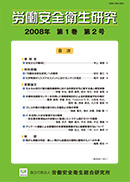Volume 1, Issue 2
Displaying 1-19 of 19 articles from this issue
- |<
- <
- 1
- >
- >|
-
2008 Volume 1 Issue 2 Pages 91
Published: 2008
Released on J-STAGE: July 02, 2013
Download PDF (111K)
-
2008 Volume 1 Issue 2 Pages 93
Published: 2008
Released on J-STAGE: July 02, 2013
Download PDF (84K) -
2008 Volume 1 Issue 2 Pages 94
Published: 2008
Released on J-STAGE: July 02, 2013
Download PDF (135K)
-
2008 Volume 1 Issue 2 Pages 95-102
Published: 2008
Released on J-STAGE: July 02, 2013
Download PDF (3154K) -
2008 Volume 1 Issue 2 Pages 103-110
Published: 2008
Released on J-STAGE: July 02, 2013
Download PDF (3153K) -
2008 Volume 1 Issue 2 Pages 111-118
Published: 2008
Released on J-STAGE: July 02, 2013
Download PDF (759K) -
2008 Volume 1 Issue 2 Pages 119-130
Published: 2008
Released on J-STAGE: July 02, 2013
Download PDF (1124K) -
2008 Volume 1 Issue 2 Pages 131-139
Published: 2008
Released on J-STAGE: July 02, 2013
Download PDF (511K)
-
2008 Volume 1 Issue 2 Pages 141-149
Published: 2008
Released on J-STAGE: July 02, 2013
Download PDF (969K)
-
2008 Volume 1 Issue 2 Pages 151-156
Published: 2008
Released on J-STAGE: July 02, 2013
Download PDF (775K)
-
2008 Volume 1 Issue 2 Pages 157-160
Published: 2008
Released on J-STAGE: July 02, 2013
Download PDF (249K) -
2008 Volume 1 Issue 2 Pages 161-163
Published: 2008
Released on J-STAGE: July 02, 2013
Download PDF (274K)
-
2008 Volume 1 Issue 2 Pages 165-166
Published: 2008
Released on J-STAGE: July 02, 2013
Download PDF (282K)
-
2008 Volume 1 Issue 2 Pages 167-169
Published: 2008
Released on J-STAGE: July 02, 2013
Download PDF (963K) -
2008 Volume 1 Issue 2 Pages 170-171
Published: 2008
Released on J-STAGE: July 02, 2013
Download PDF (637K) -
2008 Volume 1 Issue 2 Pages 172-173
Published: 2008
Released on J-STAGE: July 02, 2013
Download PDF (984K) -
2008 Volume 1 Issue 2 Pages 174-175
Published: 2008
Released on J-STAGE: July 02, 2013
Download PDF (712K) -
2008 Volume 1 Issue 2 Pages 176_1
Published: 2008
Released on J-STAGE: July 02, 2013
Download PDF (716K) -
2008 Volume 1 Issue 2 Pages 176_2
Published: 2008
Released on J-STAGE: July 02, 2013
Download PDF (716K)
- |<
- <
- 1
- >
- >|
